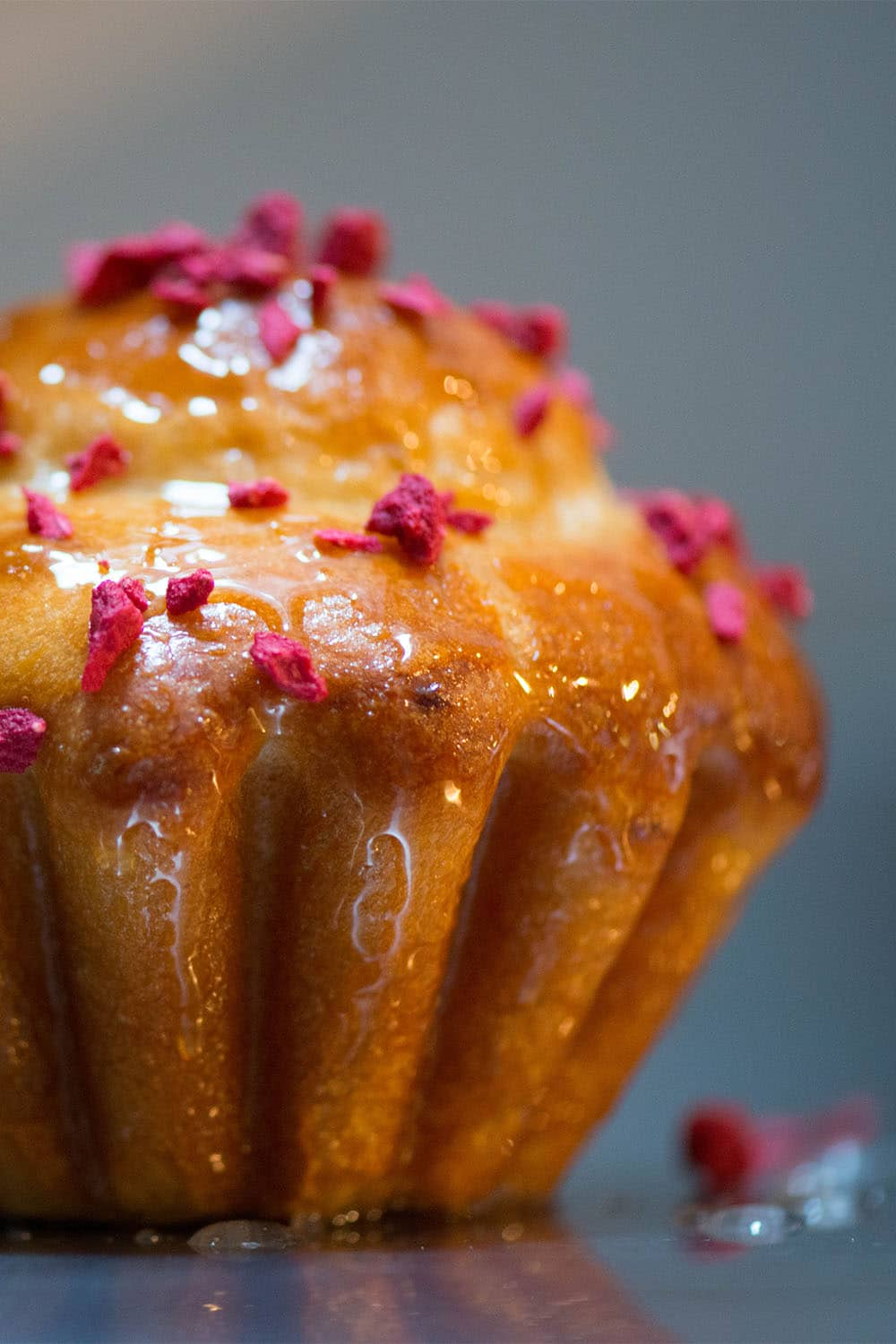
Raspberry And Rose Water Brioche Recipe
-
300 minutes prep time
-
30 minutes cook time
-
Difficult

There’s little more indulgent for breakfast or tea than plump, buttery brioche. ‘Brioche parisienne’, or ‘brioche à tête’ as they are sometimes known, are baked in round, fluted moulds and consist of two round balls placed on top of each other, a body and a head. Brioche recipes first arrived in Paris in the 17th century, originating in the dairy-farming regions of western France. Good-quality butter is hence the key ingredient in achieving that melt-in-the-mouth consistency, whilst the large quantity of eggs makes the dough rich.
We’ve added a rose water glaze to the classic French brioche recipe and a sprinkling of crispy freeze-dried raspberries - the floral fragrance and raspberry tartness contrasting beautifully with the decadent brioche.
Rose water is used in this recipe instead of water to make a rose glaze which is drizzled or brushed over the brioche to infuse it with a subtle, floral rose flavour. Meanwhile the sugar in the rose glaze also helps to form a barrier, stopping the brioche from drying out so quickly. Crispy freeze-dried raspberries work particularly well here, making the brioche look and taste that little extra bit special.

Ingredients Serves: 6
- 250g plain flour
- 250g strong white bread flour
- 25g fresh yeast or 8g dry yeast
- 12g salt
- 60g caster sugar
- 350g egg, mixed with a fork (around 6 large eggs)
- 300g unsalted butter, cold
- 4 tbsp rose water
- 120g caster sugar
- A handful of crushed freeze-dried raspberries
- Equipment - Non-stick brioche moulds and A large patisserie brush
Making the brioche
- Place the unsalted butter between two sheets of greaseproof paper. Beat the butter using a rolling pin to form a thin layer about 1cm thick. Place the butter in the freezer for 5 minutes, then transfer it to the fridge.
- Place the flours, salt, sugar and yeast in a bowl, keeping the salt and sugar on a different side of the bowl from the yeast. Mix. If you have a stand mixer, stand mixer with a dough hook attachment,
- Pour in 9/10 ths of the egg and begin to knead on the lowest setting. If the mixture looks too dry add the remaining egg.
- Increase the speed to medium and continue to knead until the dough is sticky and elastic and begins to come away from the sides of the bowl.
- Remove the cold butter from the fridge and cut into small pieces. Insert a few pieces of butter at a time into the centre of the dough. Knead slowly until the butter starts to be incorporated (you may have to reinsert the butter if it comes out of the main body of the dough.) Continue adding the butter little by little until the dough is homogenous, elastic and sticky.
- Transfer the dough to a plastic bowl, cover with cling film and leave it in a warm place to rise for 45 minutes. Outside if it’s a warm day would be perfect or perhaps in a greenhouse. Alternatively just place it in a box along with a bowl of boiling hot water - the hot steam will create the perfect conditions for the dough to rise.
- Knock back the dough on a floured surface by folding it in half a couple of times.
- Return the dough to the bowl , cover it again with cling film and leave it to one side for another 45 minutes.
- Brioche dough is very sticky, so much easier to work with when cold. Pour the dough onto a flat surface such as a baking tray (this helps it to chill faster.) Cover with cling film and leave it in the fridge for at least 45 minutes or until ready to use.
- Meanwhile, butter the brioche moulds.
Shaping and baking the brioche
- The parisienne brioche is made of two parts - the body and the head. For a large brioche, weigh out two balls of dough, weighing 130g for the body, and 70g for the head. For a small brioche, ‘petites parisiennes’ the body is approximately 25g and the head 10g.
- The secret to making them round is to put a little flour on your hands - but not on the base of the ball - and to use fast round motions to shape the dough. When shaped, place the larger ball in the brioche mould.
- Make a small hole in the middle of the dough with a floured finger. Pinch the base of the smaller ball and insert it into the hole you have made. Make sure it is well inserted so it doesn't pop out when rising.
- Return the shaped brioches to a warm place, and leave to rise for 1 – 1 ½ hours until the brioche dough is well risen, and soft and airy to the touch.
- Meanwhile preheat a fan oven to 180°C. Gently brush the surface of the brioche with a little egg and bake for 20-30 minutes until golden brown all over. Allow 10-12 minutes in the oven for the ‘petites parisiennes.’
To finish
- To make the rosewater syrup, add the rosewater and caster sugar to a pan and bring to the boil to dissolve all the caster sugar.
- Leave the rose syrup to cool slightly, then brush the brioche with it using a patisserie brush.
- Finally, sprinkle with freeze-dried raspberries - ideally just before serving to keep them crisp.



